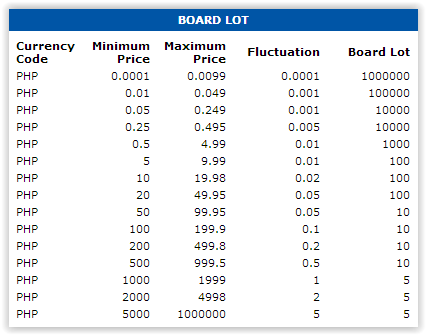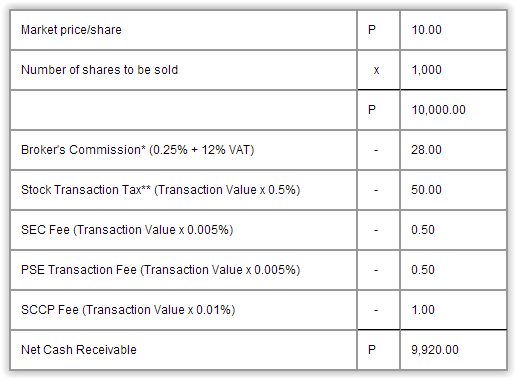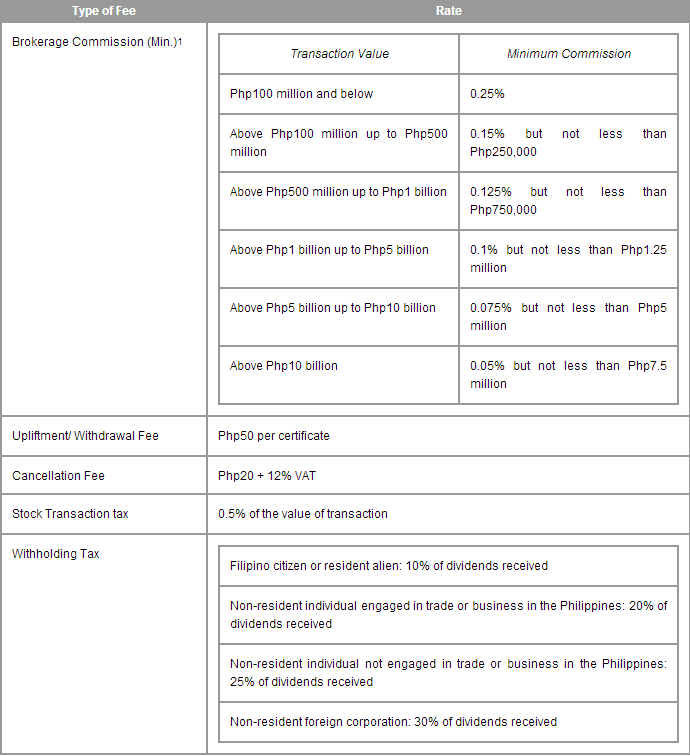PHStocks Investing 101: How to Start Investing in Stocks
Welcome to the third part of PHStock‘s “learning investing” series (you can find the first part here and second part here). In this post, we will discuss how to start investing in stocks.
(PLEASE NOTE: This article series is intended to those who ARE VERY NEW AND HAVE NO IDEA what stock investing is.)
Getting started to invest in the stock market is a relatively simple process.
1. Choose your stockbroker.
2. Open a stockbrokerage account.
3. Place your buy or sell order either online or by making a phone call to your stockbroker.
4. Monitor and keep track of your investments.
Choosing a Stockbroker
There are over a hundred licensed stockbrokers accredited by the Philippine Stock Exchange. Your choice of stockbroker should depend on the type of service you will require and who will best suit your needs. The types of stockbrokers can be classified into:
– Traditional stockbrokers: those who assign a licensed salesman to handle your account and take your orders via a written instruction or through a phone call.
– Online (via Internet) stockbrokers: those whose main interface with their customers is through the internet. Clients execute their orders and access market information directly online.
Stockbrokers vary in the range of services that they offer and the types of customers they serve, such as:
- Handling institutional or corporate accounts versus individual retail customers
- Providing advisory services
- Providing research and analysis
- Providing investor education seminars and stock market briefings
You can see the list of all accredited brokers (online and traditional) at the PSE website.
Below, meanwhile, are some of the accredited online brokers:
- AB Capital Securities Inc.
- Abacus Securities Corp.
- Accord Capital Equities Corp.
- Angping & Associates Securities Inc.
- BA Securities Inc.
- BPI Securities Corp.
- Coherco Securities Inc.
- COL Financial Group Inc.
- DA Market Securities Inc.
- F. Yap Securities Inc.
- First Metro Securities Brokerage Corp.
- Maybank ATR Kim Eng Securities Inc.
- Optimum Securities Corp.
- RCBC Securities Inc.
- Regina Capital Development Corp.
- Wealth Securities Inc.
Opening an account
Applying for an account in any of these stock brokerages is just like opening a savings account. However, do note, and this is important, that some of these stock brokers require a minimum investment amount when opening an account with them.
For instance, according to the list at PSE, AB Capital Securities requires a minimum of PhP20,000.00 as minimum investment. For Accord Capital, it’s just PhP5,000.00. Abacus Securities, meanwhile, requires PhP100,000.00. You may also have to consider the broker’s commission when opening an account. You should also consider the other services that they offer, such as those listed above.
Once you have settled in on which stock broker to acquire the services of, you are then ready to start on your investing journey.
The buying/selling process
Below is in infographic (Source: PSE-COL Primer) on how the buying and selling process happens:
Board Lot System
Stock trading is done by board lot or round lot system. The Board Lot Table determines the minimum number of shares an investor can buy or sell at a specific price range. Therefore, the minimum amount of initial investment varies and will depend on the market price of the stock as well as its corresponding board lot. Prices of stocks move through a scale of minimum price fluctuations.
Below is an example trading transaction (values taken from the PSE):
Buying Transaction:
Richard wishes to buy a stock whose market price is PhP10.00. Based on the Board Lot Table, the number of shares he can buy at a regular transaction should be in multiples of 100 shares. In this case, if Richard wants to buy 1,000 shares (which is a multiple of 100 shares) his required cash outflow will be as follows:
*Broker’s commission varies depending on value of transaction, with a maximum allowable commission rate of 1.5% (please refer to Table 2 below)
**If a buying client chooses to be issued and maintain a physical certificate in his/her name, an upliftment/withdrawal fee of PhP50.00 per certificate issuance request and transfer fee of P100.00 + 12% VAT will be charged. In the illustration above, the combined upliftment/withdrawal fee and transfer fee to be paid by the buying client will amount to P162.00 (PhP50.00 + PhP112.00).
Selling Transaction:
Richard wishes to sell a stock that is trading at P10.00. Based on the Board Lot Table, the number of shares she can sell at a regular transaction should be in multiples of 100 shares. In this case, if Richard wants to sell 1,000 shares (which is a multiple of 100 shares), her cash inflow will be as follows:
*Broker’s commission varies depending on value of transaction, with a maximum allowable commission rate of 1.5% (please refer to Table 2 below)
**Stock Transaction Tax levied on sellers only
***If a selling client has certificates, he/she needs to have this converted into book-entry form in the PCD system. A cancellation fee of PhP20.00 + 12% VAT and transfer fee of PhP100.00 + 12% VAT will be charged. In the illustration above, the combined cancellation fee and transfer fee to be paid by the selling client will amount to PhP134.40 (PhP22.40 + PhP112.00).
Trading/transaction fees and taxes
Brokerage Commission: A stockbroker is compensated for his services in executing orders on the Exchange through commission charges, which are paid by both the buyer and seller to their respective brokers.For trade transactions covering equity and equity-related products, the maximum commission rate is 1.5% of the total transaction cost plus 12% value added tax (VAT). The minimum commission rates depend on the amount of the transaction. (See Table 2)
Upliftment/Withdrawal Fee: If a buying client opts for a stock certificate to be issued in his name, he must make the request through his broker who will then issue the upliftment request through the PDTC system. Upon receipt, PDTC will then submit the request to the transfer agent for the issuance of the certificate. PDTC will charge the broker an upliftment/withdrawal fee of Php50 per certificate issuance request. The transfer agent will charge their usual issuance fee per certificate on top of PDTC’s upliftment/withdrawal fee.
Cancellation Fee: If a selling client has physical certificates, he must have the certificates converted into book-entry form in the PDTC system by requesting, through his broker, for a direct transfer (DT) with the transfer agent, which costs Php100 (plus 12% VAT) per certificate for the transfer of ownership of shares to PDTC Nominee Corporation (PCNC).
In addition to the DT fee, a client must pay cancellation fee of PhP20 (plus 12% VAT) to the transfer agent for cancellation of the certificates to be lodged in PDTC (for lodgment of shares). This is applicable only to listed equities.
Stock Transaction Tax: Sales of equities listed and traded on the PSE are subject to a stock transaction tax of ½ of 1% (50 basis points) of the value of transaction charged to the seller, in lieu of the capital gains tax. The sale, barter or exchange of shares of stock listed and traded at the PSE are exempt from documentary stamp tax.
Withholding Tax: Under the National Internal Revenue Code of 1997, and except in cases where tax treaties are in force, dividends received from domestic corporations are subject to a withholding tax of 10% if the recipient is a citizen or resident alien, 20% if the recipient is a non-resident individual engaged in trade or business in the Philippines, 25% if the recipient is a non-resident individual not engaged in trade or business in the Philippines, and 30% if the recipient is a non-resident foreign corporation. Dividends received by domestic and resident foreign corporations are not subject to tax. The rate of income tax withheld on dividends paid to a non-resident foreign corporation may be reduced to 15% if the country in which the non-resident foreign corporation is domiciled (a) imposes no taxes on foreign-source dividends or (b) allows a credit against the tax due from the foreign non-resident corporation for taxes deemed to have been paid in the Philippines equivalent to 15% of such dividends.
Although the above transaction fees and taxes (taken from PSE illustration) makes this article look a bit complicated, you can just ignore it and focus on the infographic above. Just know in your subconscious mind that everything you do has some taxes and charges. (Even buying a shampoo in your neighborhood store has been taxed already.)
Under Memo for Brokers No. 2008-0467, the minimum commission rates were made effective on October 6, 2008 and subject to further action by the Securities and Exchange Commission.
Anyway, just a recap
So our first article in this series talked about what stocks are, why you should invest in stocks, and how your money gains in the stock market. We also talked about risks involved in stock investing.
The next post talked about the pitfalls to avoid when doing your “self-evaluation” on whether or not you should invest in stocks.
Now this post, (assuming you are ready to start investing), then discussed the process to really start investing–choosing your stock broker, opening an account, understanding the buying/selling process, the board lot, and finally, the taxes and fees related to your buying/selling of stocks.
If you are still with me at this point, I’d like to congratulate you because you have taken the first step to really conquer your initial fear of this thing called stock investing (I assumed people do not go into investing in stocks because they do not know how it works, or are too afraid of already thinking about losing everything in the stock market–a misconception brought about by the reckless traders). I hope this series has helped you decide to start improving the future of your finances through investing in the stock market.
The next posts will discuss some stock investing strategies you may (or may not–I am cool with it) consider, as well as some key pointers when managing your portfolio.







Pingback: Building Wealth from Scratch | PHStocks